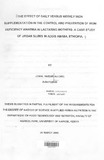| dc.description.abstract | This study was designed to take a sequential step, comprising a cross sectional study
with a longitudinal observation, to demonstrate the biological effectiveness and social
feasibility of weekly versus daily iron supplementation in the control and prevention of
'"
anaemia in women of reproductive age. It compares the haemoglobin, serum ferritin
and compliance in Teklehaimanot Wereda, Ethiopia between March and May 2001. A
total of 1017 lactating women were recruited, and screened clinically and
biochemically for anaemia; out of which, only 207 of the women were found to be
eligible and enrolled in this study. After an informed written consent was obtained from
all the subjects, they were then assigned to the daily, weekly supplementation or
control groups following randomisation.
The daily group (n=71) received 60 mg of elemental iron containing 300 mg ferrous
sulphate with 400 IJg folic acid from Monday to Friday, while the weekly group (n=68)
received only one tablet of iron of the same content once a week, every Monday
supervised by the field workers; and the control group (n=68) was advised to take no
iron tablets or other drugs without the knowledge of the investigator until the
completion of the study. Before the supplementation of iron, every subject was
dewormed with 120 mg levamisole, and then baseline information on sociodemographic,
nutritional status, and the appropriate laboratory tests taken from all
groups.
11
To evaluate the outcome of the study, haemoglobin from all and serum ferritin from a
sub-sample of the subjects were measured before and after the completion of the
study; and compliance was observed every two weeks by the researcher together with the
field workers. The mean age, household size, parity, frequency of meals, body mass index,
education, employment status, baseline haemoglobin and serum ferritin levels of the groups was
not significantly different between groups indicating that the groups enrolled were homogenous.
Ascariasis (17.9%), strongyloidiasis (2.4%), and hookworm (1.9%) were found to be the
commonest infestation, and had a close association with low serum ferritin concentration
(P=0.05) in the Wereda. To see the confounding effect of contraceptive, information was
collected and analysed among the groups. The commonest (55.4%) type of contraceptives
used was pills and injection and were nearly uniform in all the groups. No association was
observed between contraceptive use and level of anaemia (P=0.5). Chronic energy deficiency in
the Wereda was higher (27.0%) when compared with the figure for Addis Ababa Administrative
region, which was (17.9%). Prevalence of anaemia, as determined by haemoglobin
concentration in the Wemda was 22.3% and iron deficiency (determined by serum ferritin below
12 !J.g/litre)22.6% and iron deficiency anaemia (determined by serum ferritin below 12 !J.g/litre
and haemoglobin less than 12 gm/dL) 22.3%. Following the supplementation, significant
increase in haemoglobin concentration and a three fold reduction in the prevalence of anaemia
in both the daily and weekly supplemented groups were found. When the daily and weekly
supplementations groups were compared, the therapeutic effectiveness was equally significant
in both schedules. The reports of side effects observed in this study were related to the | en |

